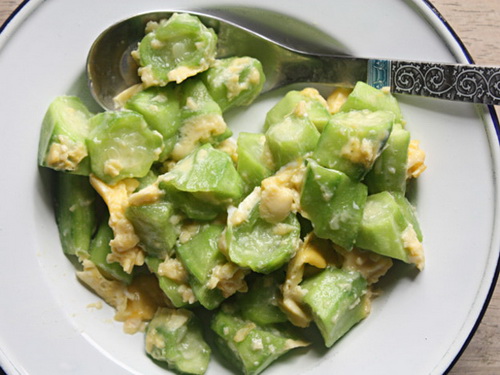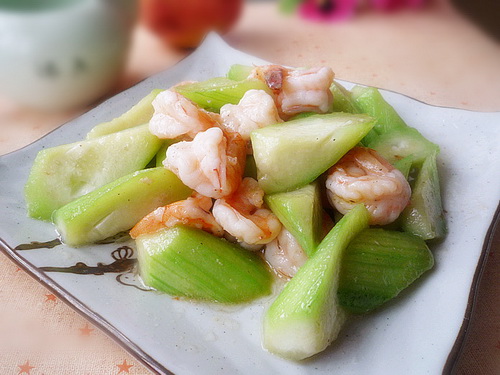Most westerners have never heard of sigua (丝瓜), but many have actually encountered it before in the form of loofah sponges. The latter are the fibrous, fully mature version of this common Chinese vegetable, also known as “Chinese okra,” “luffa,” or “angled gourd” in some parts of the West.
Sigua is harvested for consumption when the fruit is still tender and green. During the summer growing season, it is planted from June to September and harvested from July to November. This healthy, mild-tasting crop lends itself well to light dishes; here are five easy ways to cook with it at home.
Stir-fried loofah with shrimp 丝瓜炒虾仁 (sigua chao xiaren, pictured above)
Peel the loofah and dice it into large pieces. Soak a handful of deveined and shelled shrimp in a small bowl of rice wine and cornstarch for ten minutes. Stir-fry the shrimp in some oil until it changes color, then remove and drain. Toss some julienned scallions into the same wok, add the loofah and stir-fry until light green and translucent. Add the shrimp, heat through, then season with a pinch of salt, a splash of rice wine, and a little bit of chicken stock. Serve while hot. Original recipe here(Chinese-only).

Stir-fried loofah with egg 丝瓜炒鸡蛋 (sigua chao jidan)
Similar to the first entry on this list, but vegetarian-friendly. Click here for a super easy recipe in English from Serious Eats; simply omit the fish sauce or substitute rice wine for a version free of animal products.

Pork and luffa soup 丝瓜猪肉汤 (sigua zhuro tang)
This Cantonese-style dish makes a great summer soup. Recipe here. If you don’t eat meat, try substituting tomatoes and tofu or egg instead. You can also add a handful of goji berries for an extra nutrient kick.

Steamed garlic and loofah 蒜茸蒸丝瓜 (suanrong zheng sigua)
Peel one loofah and slice into thick cylindrical sections. Slightly hollow out the top of each section. Puree several cloves of garlic. In a small bowl, mix the garlic with a bit of powdered chicken bouillon (optional) and peanut oil. Place the mixture into the hollowed-out portion of each loofah section, then steam for three minutes and serve. Original recipe here (Chinese-only). Many versions of this recipe also feature glass noodles; simply serve the steamed loofah on a bed of these.

Loofah porridge 丝瓜粥 (sigua zhou)
Upset stomach? Nosh on this two-ingredient porridge. Simply set your rice cooker to the porridge (粥) function and add some sliced loofah when it’s nearly done with a pinch of salt for seasoning. You can also toss in some 1,000-year egg (松花蛋, songhua dan) if you’re into that.
When produce is available year-round at Beijing’s farms and greenhouses, it’s easy to forget that each fruit and vegetable has its own sowing and harvesting cycle. Eating seasonally not only ensures the best-quality produce, it also helps maintain our body’s yin and yang balance, according to TCM. The Seasonal Eats series, a regular column on beijingkids, introduces foods best eaten this month.
Photos: Meishi China, Andrew Grygus (Clove Garden), Leela Punyaratabandhu (via Serious Eats), Xiachufang, Baike Baidu


